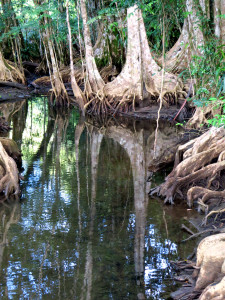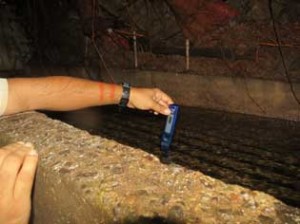PIEDRA BLANCA NATIONAL PARK, COSTA RICA
By CHANTAL COOKE
It’s slightly incongruous – I am in a corner of paradise in Costa Rica and there is the distinct aroma of mince and onions cooking. What’s even odder is that this isn’t a scent created by food – but rather by wild pigs.
The pigs roam in the Piedra Blanca National Park in the south west of Costa Rica and the food they eat gives off this distinctly ‘school dinners’ smell! Not quite what you expect when your view is ocean and palm trees.
But don’t let the perfume put you off… this is a beautiful area of Costa Rica – even by Costa Rican standards.
I am staying at Playa Cavito – named after the trees that surround it. It’s situated on the Golfo Dulce Bay looking across the water to Osa Peninsula.

If you have come to see wildlife then you won’t be disappointed. While eating breakfast I spotted an agouti mother and baby, a white nosed coati with its tail held high, black mandible toucans, a grey blue tanager and a brown pelican soaring just above the water. And the day had hardly started.

Cativo offers a number of activities and as the property has some pretty impressive green credentials I thought I’d check out their organic farm, followed by a hike to the mini dam that produces hydroelectric power to supply the majority of the property’s needs.
The walk to the farm takes you on a gentle trail through secondary forest. A family of coatis rustle through the undergrowth and white faced capuchin monkeys leap between the trees. A blue crested motmot swings its pendulum-like tail and a large Jesus Christ lizard (so named due to its ability to walk on water) scuttles up a tree trunk. Tiny crabs hurry among the tree roots digging holes in the dirt or enjoying the water that’s collected in the bromeliads. These are forest crabs – never venturing to the beach and beyond.

As the forest thins and we enter a clearing – named after the mince and onions pigs – a red macaw flies overhead. It’s unusual to see them alone – they tend to fly in pairs.
At the farm we inspect the plants and learn about the challenges of growing fruit and vegetables so close to salt water. Close by there is a bush with gorgeous red spiny fruits. It’s Vixaorellana (known as Achiote in Spanish). If you open the fruit it contains tiny soft, red seeds. Crushed between your fingers they release an intense red pigment – this is used as a food colouring, an insect repellent, and as a pigment for decorating skin and clay pots; a far more attractive (and kind) option than the European love affair with cochineal.

As we wander back along the tree line where it meets the beach red clawed crabs dash to their holes to hide, tiny hermit crabs struggle with their homes on their back, and a large alpha male howler monkey picks figs from the trees. This is where your nature guide is invaluable. The howler monkey was right above my head – and I hadn’t spotted it! Thankfully Mario, our guide, doesn’t miss much!

From here we cross to the track behind the hotel. It’s a steep, challenging climb though primary forest, clambering over huge roots, ducking under low hanging branches and trying to find a secure footing in the damp soil and dead leaves. At last the trail flattens and we look down onto the trees below. Four long nose bats cling to the side of a large tree, snoozing the day away. Red tailed squirrels leap from branch to branch above our heads.
We pick our way along the trail until we reach the stream, then it’s a slippery hike upstream, leaping from one moss covered rock to another. Waterproof shoes are definitely an asset here. Eventually we reach a tiny dam and Mario tests the water. The readings tell him the quality of the water is good – so good in fact that we could drink the water right here.
This tiny dam produces a flow of water that rushes down the hillside to turn a turbine at the hotel, which in turn produces electricity for the hotel and its guests.

It’s a great hike, with an interesting message and reinforces how this property really is doing its best to minimise its environmental impact; something that sits comfortably alongside Costa Rica’s reputation as a first class wildlife destination.
After lunch, if you want to get close to nature, but from the water this time, then I’d recommend kayaking. The water is warm, the kayaking easy and there’s plenty of wildlife; large needle fish with their pointed noses slip through the water looking for a fight, tiny jack fish break the surface, and snappers, in a variety of sizes, peer curiously at the bright red kayaks. Above an osprey circles, and level with us on the water a brown pelican glides gracefully just above the surface. Brightly coloured sailor crabs cling to the rocks and howler monkeys let loose their terrifying cries in the trees.
Wildlife seldom comes with a guarantee and can often be difficult to spot, but here in the Piedra Blanca National Park, with the help of a local guide, you’ll be falling over nature in all its glory.
FACT BOX:
Playa Cativo – http://www.playacativo.com/
Visiting Costa Rica – www.visitcostarica.com

About the Author:
Chantal Cooke is an award winning journalist and broadcaster with a passion for the planet. In 2002 she co-founded the award winning radio station PASSION for the PLANET and in 2009 Chantal was awarded London Leader in Sustainability status. Chantal also runs a successful communications agency – Panpathic Communications.
